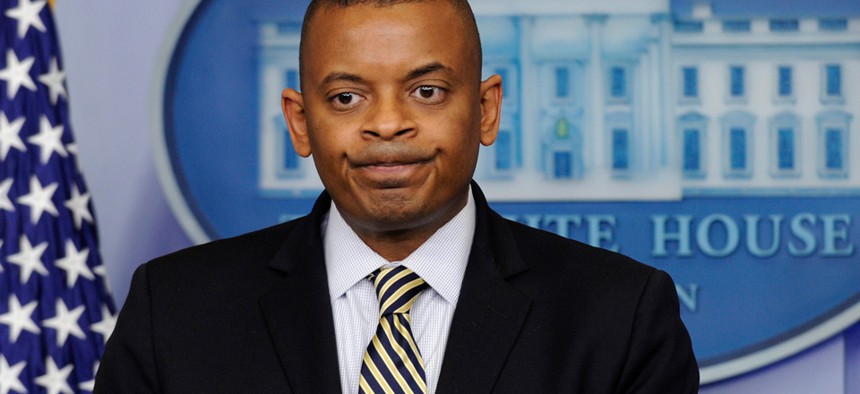Techie Alert! The Transportation Department Needs You

AP file photo
DOT Secretary Anthony Foxx unveils 30-year report in a telling place, Google headquarters.
One of the smugger observations about the Transportation Department's new working paper on the country's 30-year infrastructure outlook came from the tech-central news site CNET: "What might seem run-of-the-mill in the San Francisco Bay Area these days impressed the high-ranking Washington politico."
Wayne Cunningham, the CNET writer, was referring to Transportation Secretary Anthony Foxx's visit to Google headquarters last week to unveil the agency's report, "Beyond Traffic," which is intended to spark conversation about where we are going as a country when it comes to moving ourselves and our stuff around. Foxx rode in a driverless car to the Google campus to deliver his remarks, and he loved it. This, he more or less said, is the kind of innovation that will fix the future, which looks pretty bleak without a lot of investment in such excellent gadgets. "We need to focus on the trends that are shaping our future," he said. "It is time to sound the alarm bell."
He most certainly did. The Beyond Traffic "blue paper," which is billed as an outline of the longer report but reads more like ad copy, paints a harrowing picture of the U.S. transportation system in 2045. "A driver sits in traffic for hours, which may have been common in Los Angeles a generation before. [blank space for dramatic pause] But this particular driver lives in Omaha, Nebraska."
That's only the beginning. There is also a "businesswoman" who can't board train after train on the Long Island Rail Road because each one is too full. "Now, the woman wonders not just whenshe will get to work… [dramatic blank space and bigger, bolder letters]"But if she will get there at all."
Scare tactics aside, what emerges from a closer reading of the full report shouldn't be a surprise: Road congestion and transit backlogs will continue to worsen, to the point of gridlock, if infrastructure development operates under the same paradigms and financing levels of the past 50 years. The movement of freight, for example, is on an upswing with the advancements of online shopping, just-in-time shipping, and international trade. Can the highways handle an additional 10 million trucks belching out diesel exhaust? If there are already bottlenecks in the freight delivery system, won't the movement of goods to market essentially stop?
Foxx insists it doesn't have to be this way if industry professionals and regulators start thinking creatively, really creatively. That means forgetting transportation jargon, challenging long-held assumptions, and courting new partners in the endeavor. Those new partners would be the techies. Foxx's overt courting of the tech community landed pretty cleanly, if this headline fromInvestor's Business Daily is any indication: "Can Techs Like Google Fix a Future of Traffic Jams?
There is a touch of eye-rolling from techies, akin to a teenager who teases his mother for using her phone to "just talk" and not text. "The USDOT seems to be really excited about millennials and ride-sharing," wrote Chris Ziegler of The Verge. Also, he added, "Self-driving cars are definitely happening, because the regulatory people are on board."
Eric Jaffe of The Atlantic's City Lab homed in on the most important notion for this new type of thinking—choice. Foxx believes, like many urban planners, that people need several options for how to get from here to there, and the network of choices should be seamless, allowing a simple shift from to another.
Foxx still needs a little training in his new world. He described the concept to Google Executive Chairman Eric Schmidt as "multimodal," a familiar term to transportation officials that is loaded with nuance (usually as a plug for transit). But Schmidt, who is not in this cloistered world, asked for clarification. Bus? Car? Train?
"Choice," Foxx told him. "Giving people choices."
This, perhaps coincidentally, is exactly the vision that transit enthusiasts and environmentalists have been pushing for years. Like DOT, they also are embracing new technologies and innovations as ways to get people out of their polluting cars. A new report from U.S. PIRG and the Frontier Group ranks 70 cities based on the range of options they offer to people that don't involve driving their own cars. The list includes old standbys like taxis but also new technologies like GPS-based real-time transit information and ride-sourcing services like Uber, Lyft, and Sidecar. (Austin, Texas, is No. 1 on that list, followed by San Francisco and Washington.)
The authors' conclusions dovetail nicely with Foxx's vision: "These tools have been expanding rapidly, yet public agencies have been slow to integrate these new systems into their planning and policy toolbox."
The DOT report puts it this way: "How will we align decisions and dollars, and invest the trillions of dollars our transportation system needs in the smartest way possible? …Beyond Traffic does not close the book on these questions. It opens the book wider, giving all of us more and better data with which to answer them."
Game on, guys.
NEXT STORY: NIH seeks app to recognize pills


